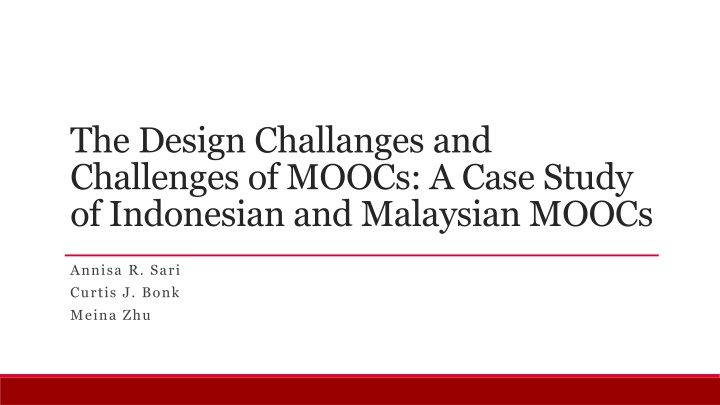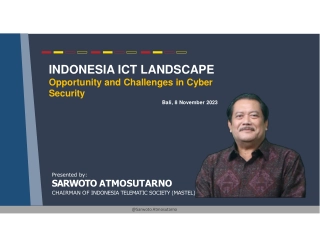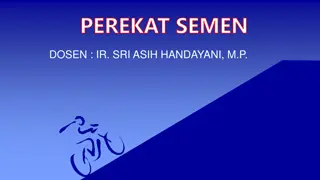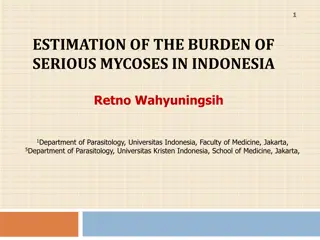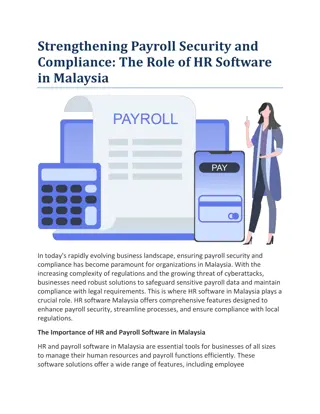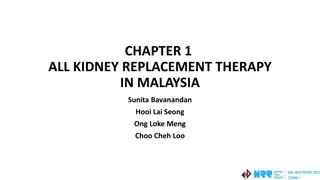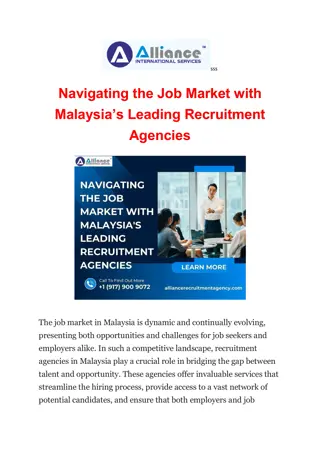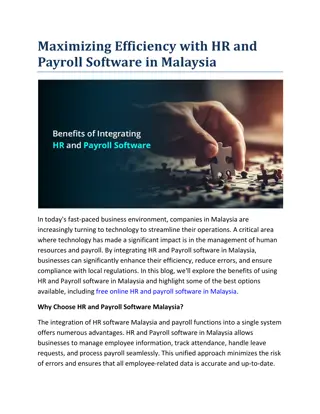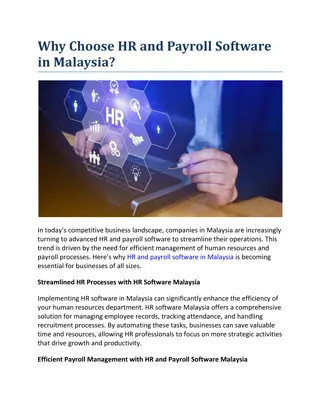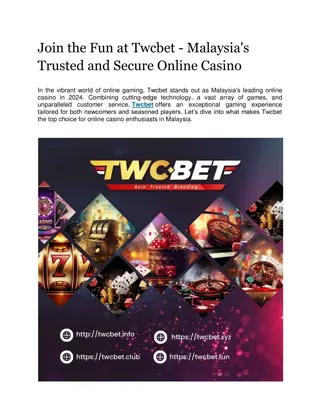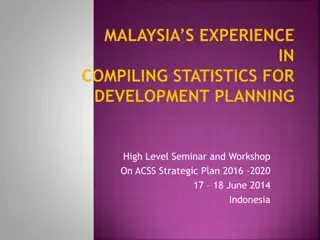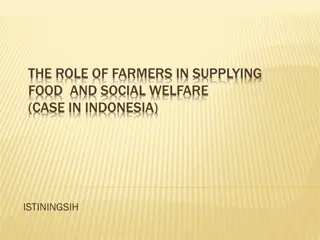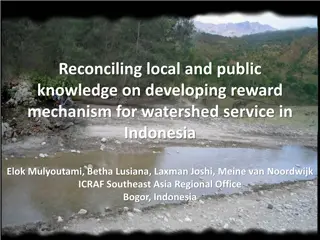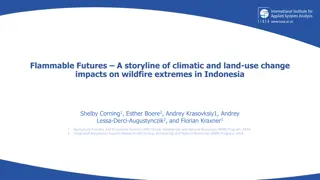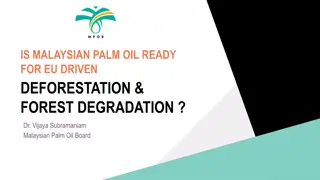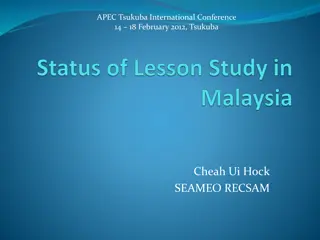Case Study of MOOC Challenges in Indonesia and Malaysia
MOOCs have gained traction in Indonesia and Malaysia, presenting design challenges and research gaps. Explore how instructors design MOOCs, the challenges they face, and key findings on demographics and providers.
Download Presentation

Please find below an Image/Link to download the presentation.
The content on the website is provided AS IS for your information and personal use only. It may not be sold, licensed, or shared on other websites without obtaining consent from the author.If you encounter any issues during the download, it is possible that the publisher has removed the file from their server.
You are allowed to download the files provided on this website for personal or commercial use, subject to the condition that they are used lawfully. All files are the property of their respective owners.
The content on the website is provided AS IS for your information and personal use only. It may not be sold, licensed, or shared on other websites without obtaining consent from the author.
E N D
Presentation Transcript
The Design Challanges and Challenges of MOOCs: A Case Study of Indonesian and Malaysian MOOCs Annisa R. Sari Curtis J. Bonk Meina Zhu
Background During the past few years, MOOC courses have been increasingly designed and delivered in countries outside of U.S. and Europe including SE Asian countries. The growth of MOOC development in Malaysia has fostered growing research interest in Malaysian MOOCs (e.g., Al-Atabi & DeBoer, 2014); however, there remains a lack of research focused on Indonesian MOOCs. 2
Background Some critiques related to MOOCs. There is a dearth of research investigating instructor aspects of MOOCs (Zhu, Sari, & Lee, 2018). This study is beneficial for the stakeholders in Indonesia to understand how certain MOOCs are designed and offer suggestions for future MOOCs instructors/designers/institutions, esp. From SE Asian perspectives. 3
Research Questions: Research questions: 1. How do instructors design their MOOC? 3. What challenges do instructors experience in designing their MOOC? 4
Key Terms MOOCs = online course that is based on self-motivated learning, and flexibility (Israel, 2015;). The openness = no specific requirements regarding academic qualification, fees, and course completion (Liyanagunawardena, 2015;). The massiveness = the large number of students (Anderson, 2013). 5
Method Research Design: mixed method design (Creswell, 1999) Data Collection: Survey, interview Participants: 46 survey participants (15.6%) and 9 interviewees (3 Malaysian + 6 Indonesian) 6
Data Analysis RQ RQ1 Data Sources Survey multiple-choice questions Interview Data Analysis Descriptive Statistics (Knupfer & McLellan, 1996) Content analysis (Vaismoradi, Turunen, & Bondas, 2013) Descriptive Statistics Content analysis RQ2 Survey multiple-choice questions Interview 7
Findings-Demographics MOOC Providers (n=46) 24 8 5 5 3 1 Akademi CIPS FOCUS Fisipol UGM iMOOC MOOCs Universitas Terbuka IndonesiaX Open Learning (Malaysia) 8
Findings-Demographics Primary Discipline Affiliation (n=46) Education 10 Social Sciences 9 Mathematics, Statistics, and Computer Sciences 6 Business and Management 4 Engineering and Architecture 4 Health Sciences 4 Other 4 Humanities 2 Law 2 Agriculture 1 Natural Sciences 0 9
Findings-Demographics The Number of Participants (n=46) 36 9 1 0 0 0 Less than 1,000 1,000-5,000 5,001-10,000 10,001-20,000 20,001-50,000 More than 50,000 10
Findings-RQ1 Preparation: Build a team work Familiarize myself with various design tools Join in other MOOC courses Investigate MOOC environment Seek advice from any MOOC or regular online course instructor 11
Findings-RQ1 Attraction: Provide course information Offer recognition (e.g., certificate, badge, points, credits) Design a list of steps to complete the course Provide welcoming lectures Lay out instructor s expectations 12
Findings-RQ1 In order to attract students to enroll in the course, one interviewee use course information: I explain what content will be discussed in this course, and the goal of this course. Sometimes students send email to me, and ask about the course or certificate. 13
Findings-RQ1 Participation: Certificate/badge, The use of multimedia Assign optional readings, video, other materials Attempt to create learning communities Provide quizzess How to track: Self monitoring, learning analytics, personal tracking from instructors 14
Findings-RQ1 One of the interviewee stated that his MOOC course is equipped with learning analyticsto track students progress: We are equipped our LMS with Learning Analytics. Learning Analytics (LA) is currently being widely used by online learning providers to enhance learning process and to boost student engagement and interaction. The LA can be used as both a prescriptive tools and predictive measures. It collects information about the student access to learning resources, interactions and activities. LA provides real time visual image of student learning behaviors. It is easy to manage and operate. 15
Findings-RQ1 Assessment: How do participants obtain feedback? Quizz/test Instructor Student portofolio Peer Student presentation Moderator/Tutor/TA Student log data Papers 16
Findings-RQ1 One interviewee mentioned several ways to assess students learning: we provide ........ and varieties of ways for measuring participants learning result such as participation in guided discussions, quizzes, essay writing, involve in individual or group projects, etc. 17
Findings-RQ2 RQ2: What challenges do instructors experience in designing their MOOC? participant engagement, encouraging collaboration video development, and time constraints Assess participants learning Help for solutions: Other instructors, provider, institution 18
Findings-RQ2 One interviewee mentioned that student engagement is challenging and crucial: Students engagement is vital ... to engage in a meaningful learning is a challenge especially with an instructor, peers and course content. Regarding time constraint, another interviewee stated that: First of all this project is conducted at the same time we all have to complete our regular job so sometimes time management can be an important issue...... There are moments we cannot reach one or two of the developers because they were too busy with their work or they feel that this program does not provide strong financial support for them. 19
Discussion During the preparation, attraction, participation, and asessment stages, instructors used several strategies in their design The 5 top design challenges for instructors in MOOCs include encouraging collaboration, participant engagement,video development, time constraints, and assessment Pedagogical and technological challenges are still the common challanges to be handled 20
Implication The findings of this study give an implication that MOOC course design needs full support from the entire MOOC team as well as their institution. The work sharing, availability of various content and technology resources, and the legal, administrative, and instructional design support can ease the instructors responsibilities. 21
Implication It is important for the institution to provide guidance and training to these instructors, or assign a video maker professional to support MOOC instructors in designing their course (Ritcher & Krishnamurthi, 2014). 22
Limitation & Future Direction The MOOC course design strategies is approached from the perspectives of instructors only. Future research can expand these findings by adding more perspectives from students, affiliated institutions, and MOOC providers. This study only focuses on MOOCs developed by Indonesian and Malaysian instructors. There is now an opportunity to extend the study to a bigger context such as to additional countries in southeast Asia or perhaps the world community. 23
References Abas, Z. W. (2015). The glocalization of MOOCs in southeast Asia. Bonk, Lee, Reeves, & Reynolds (Ed.), MOOCs and open education: Around the world, 232-242. Anderson, Terry. (2013). Promise and/or peril: MOOCs and open and distance education. Retrieved on April 26, 2017 from http://www.col.org/SiteCollectionDocuments/MOOCsPromisePeril_Anderson.pdf Creswell, J. W. (1999). Mixed-method research: Introduction and application. Handbook of educational policy, 455-472. Fadzil, M., Latif, L. A., & Munira, T. A. M. (2015). MOOCs in Malaysia: A preliminary case study. MOOCs in Malaysia: a preliminary case study. Retrieved from: http://library.oum.edu.my/repository/1022/1/library-document-1022.pdf Hew, K. F., & Cheung, W. S. (2014). Students and instructors use of massive open online courses (MOOCs): Motivations and challenges. Educational Research Review, 12, 45-58. Israel, M. J. (2015). Effectiveness of Integrating MOOCs in Traditional Classrooms for Undergraduate Students. International Review of Research in Open and Distributed Learning, 16(5), 102 118. Retrieved from? McAuley, A., Stewart, B., Siemens, G., & Cormier, D. (2010). The MOOC model for digital practice. Retrieved from http://www.elearnspace.org/Articles/MOOC_Final.pdf Mercado, S., Parboteeah, K. P., & Zhao, Y. (2004). On line course design and delivery: cross national considerations. Strategic Change, 13(4), 183-192. Wong, B. T. (2016). Factors leading to effective teaching of MOOCs. Asian Association of Open Universities Journal, 11(1), 105-118. Zhu, M., Sari, A. & Lee, M. M. (2018). A Systematic Review of Research Methods and Topics of the Empirical MOOC Literature (2014-2016). The Internet and Higher Education. 24
Thank you. Questions and Comments 25
